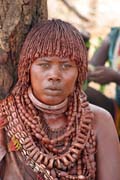
Marabou Storks are one of the largest flying birds in the world. A large male Marabou Stork, standing up to 1.5 m (60 in) tall and weighing nearly 9 kg (20 lbs); their wingspan is nearly 2.9 m (10.5 ft). Females are generally smaller. As scavengers, they eat pretty everything, whether alive or not. They like to pick through lions’ and tigers’ leftovers.

Hamar women are extremely beautiful. Everybody in Ethiopia knows them and everybody talks about them. Hamars live at the lower Omo River. Hamars originated as mixture of different tribes used to be living there.

Banna and Tsamai people are the first tribes you will meet on the way to Omo River at southern Ethiopia. When you first see them, you understand what really does mean to be in Africa with people still living the same life as they used to live hundred years ago.

Ethiopia is amazing multicultural country. One of its most interesting regions with high diversity of different people is Omo River area. The Omo River springs from Mount Amhara, located nearby of the capital Addis Ababa, and flows through deep valleys and harsh scenery of Ethiopian countryside with little villages around, crossed by narrow winding cattle paths up to the Turkana Lake at the Ethiopian-Kenya borders. There are no roads, no development, and just deserted county.

I will start my trip to Omo after 4 days, after Timkat holiday. Timkat is something special so today I am going to move to Gonder to see celebration. Timkat is celebrated through whole country (well Christian part of the country) but three places attracts more pilgrims than others. Addis Abeba, Gonder, and Lalibela are these three places. Last year I visited Timkat at Lalibela so this year is time for change. That’s why I want to go to Gonder to see celebration inside Fasiladas’ Baths.

After one hour we take off. I am happy. I am returning to Ethiopia which is my lovely country. This is my second visit almost exactly after 12 month. This trip will be little bit different. Last year I visited north historical circuit, this year I plan to go south to Omo valley and little bit to the east to the Bale Mountain National Park. I expect it will be quite different from last trip.

When you visit Ethiopia you will get impression of the national coffee culture. Small coffee shops are around the whole country. People sit here and drinking traditional strong coffee. Everybody knows Japanese tea ceremony, but it is not so much known that at Ethiopia is tradition of Coffee ceremony. Coffee origin is not known – Ethiopian people say it is from Ethiopia, people from Yemen say it is in their country. But one thing is clear – Ethiopia has rich coffee culture.

Ethiopia is a very religious country. More than 80% people are orthodox Christians. All religious traditions are very living. One of the most important orthodox holidays is Timkat.